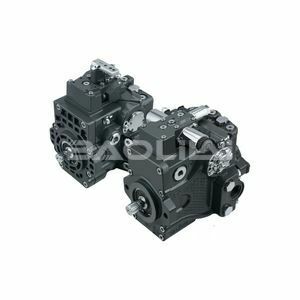Important functions and features of axial piston pump front cover
The front end cover of an axial piston pump is an important component and plays a vital role in the operation and performance of the pump. It is usually located on the front or inlet side of the pump and serves several important functions. The specific characteristics of the front end cover may vary depending on the pump design and manufacturer, but the following are some common features and characteristics associated with axial piston pump front end covers:
1. Inlet: The front end cover usually has an inlet through which hydraulic oil or oil is sucked into the pump. This port connects to the hydraulic tank or supply source.
2. Mounting flange: The front end cover usually has a mounting flange to enable the pump to be securely connected to the hydraulic system or machine. The design of this flange may vary depending on the specific pump model.
3. Seal surface: The front end cover is designed to provide a seal to the pump housing or cylinder to prevent fluid leakage. This area typically uses high-quality seals and gaskets to maintain fluid integrity.
4. Drive connection: In some axial piston pump designs, the front end cover includes the means for connecting the pump to the drive mechanism (such as an electric motor or internal combustion engine). This connection is critical to the mechanical operation of the pump.
5. Pressure relief valve: Some axial piston pumps are equipped with a pressure relief valve on the front end cover to protect the pump from overpressure conditions. This valve releases excess pressure back to the reservoir.
6. Flow control function: Depending on the design of the pump, the front end cover may include a flow control or adjustment function to regulate the flow and pressure output by the pump.
H1-P-210-L-A-A-A5-C2-N-D8-E-G2-H2-L-42-L-42-R-P-28-P4-NNN-NNN H1P210LAAA5C2ND8EG2H2L42L42RP28P4NNNNNN
H1-P-210-L-A-A-A5-C2-N-D8-C-G3-NN-L-42-L-42-R-P-24-PN-NNN-NNN H1P210LAAA5C2ND8CG3NNL42L42RP24PNNNNNNN
H1-P-210-L-A-A-A5-C2-N-D8-C-G3-NN-L-40-L-40-W-P-24-PN-NNN-NNN H1P210LAAA5C2ND8CG3NNL40L40WP24PNNNNNNN
H1-P-210-L-A-A-A5-C2-N-D8-C-G3-H3-L-42-L-42-R-P-24-PN-NNN-NNN H1P210LAAA5C2ND8CG3H3L42L42RP24PNNNNNNN
H1-P-210-L-A-A-A5-C2-N-D8-C-G3-H2-L-42-L-42-R-P-24-PN-NNN-NNN H1P210LAAA5C2ND8CG3H2L42L42RP24PNNNNNNN
H1-P-210-L-A-A-A5-C2-N-D8-C-G2-H3-L-38-L-38-R-P-24-PN-NNN-NNN H1P210LAAA5C2ND8CG2H3L38L38RP24PNNNNNNN
H1-P-210-L-A-A-A5-C2-N-D6-C-G3-NN-L-42-L-42-W-L-20-PN-NNN-NNN H1P210LAAA5C2ND6CG3NNL42L42WL20PNNNNNNN
H1-P-210-L-A-A-A5-C2-B-D8-E-G3-H3-L-40-L-40-R-P-34-P4-NNN-NNN H1P210LAAA5C2BD8EG3H3L40L40RP34P4NNNNNN
H1-P-210-L-A-A-A5-C2-B-D8-E-G2-NN-L-42-L-42-R-P-24-P4-NNN-NNN H1P210LAAA5C2BD8EG2NNL42L42RP24P4NNNNNN
H1-P-210-L-A-A-A5-C2-B-D8-E-G2-H6-L-42-L-42-R-P-24-P4-NNN-NNN H1P210LAAA5C2BD8EG2H6L42L42RP24P4NNNNNN
H1-P-210-L-A-A-A5-C2-B-D8-C-G3-H2-L-42-L-42-R-P-24-PN-NNN-NNN H1P210LAAA5C2BD8CG3H2L42L42RP24PNNNNNNN
H1-P-210-L-A-A-A5-C2-B-D8-C-G2-NN-L-35-L-35-R-P-24-PN-NNN-NNN H1P210LAAA5C2BD8CG2NNL35L35RP24PNNNNNNN
H1-P-210-L-A-A-A5-C2-B-D8-C-G2-H6-L-35-L-35-W-P-24-PN-NNN-NNN H1P210LAAA5C2BD8CG2H6L35L35WP24PNNNNNNN
H1-P-210-L-A-A-A5-C2-B-D8-C-G2-H6-L-35-L-35-R-P-24-PN-NNN-NNN H1P210LAAA5C2BD8CG2H6L35L35RP24PNNNNNNN
H1-P-210-L-A-A-A5-C2-B-D8-C-G2-H4-L-35-L-35-W-P-24-PN-NNN-NNN H1P210LAAA5C2BD8CG2H4L35L35WP24PNNNNNNN
H1-P-210-L-A-A-A5-C2-B-D8-C-G2-H3-L-35-L-35-R-P-24-PN-NNN-NNN H1P210LAAA5C2BD8CG2H3L35L35RP24PNNNNNNN
H1-P-210-L-A-A-A5-C2-B-D6-C-G2-NN-L-33-L-33-R-L-24-PN-NNN-NNN H1P210LAAA5C2BD6CG2NNL33L33RL24PNNNNNNN
H1-P-210-L-A-A-A5-C2-B-D6-C-G2-H6-L-35-L-35-W-L-24-PN-NNN-NNN H1P210LAAA5C2BD6CG2H6L35L35WL24PNNNNNNN
H1-P-210-L-A-A-A5-C2-B-D6-C-G2-H5-L-35-L-35-W-L-24-PN-NNN-NNN H1P210LAAA5C2BD6CG2H5L35L35WL24PNNNNNNN
H1-P-210-L-A-A-A5-C2-B-D6-C-G2-H3-L-35-L-35-W-L-24-PN-NNN-NNN H1P210LAAA5C2BD6CG2H3L35L35WL24PNNNNNNN
7. Material: Front end caps are usually made of durable and corrosion-resistant materials, such as cast iron, aluminum, or other suitable alloys. Material selection may vary depending on the application and the fluid being pumped.
8. Port configuration: The number and configuration of inlet and outlet ports on the front end cover can vary based on the specific axial piston pump design and application requirements.
9. Access points: Some front end caps have access points for maintenance and inspection, including means for replacing seals and other internal components.
10. Design differences: Different axial piston pump manufacturers may have their own unique front end cover designs and functions, so the characteristics of different models and brands may vary greatly.

11. Cooling and Lubrication: In some applications, the front end cover may have cooling and lubrication devices. This may involve the integration of cooling channels or lubrication channels to ensure the pump operates at the appropriate temperature and maintains proper lubrication.
12. Noise reduction: Some front end covers are designed to reduce noise and vibration generated during pump operation. These features may include sound-absorbing materials or damping structures.
13. Modular: In some designs, the front end cover is a modular component, which means it can be easily removed and replaced, making maintenance and repairs more convenient.
14. Suction filter: Some axial piston pumps are equipped with a suction filter in the front end cover to prevent contaminants from entering the pump and possibly causing damage.
15. Pressure compensator: The front end cap houses the pressure compensator mechanism, allowing the pump to adjust its output pressure based on system needs, providing a degree of control and energy efficiency.
H1-P-210-L-A-A-A5-C1-N-D8-C-G3-NN-L-35-L-35-R-P-26-PN-NNN-NNN H1P210LAAA5C1ND8CG3NNL35L35RP26PNNNNNNN
H1-P-210-L-A-A-A5-C1-N-D8-C-G2-NN-L-35-L-35-W-P-24-PN-NNN-NNN H1P210LAAA5C1ND8CG2NNL35L35WP24PNNNNNNN
H1-P-210-L-A-A-A5-C1-N-D8-C-G2-H6-L-35-L-35-W-P-24-PN-NNN-NNN H1P210LAAA5C1ND8CG2H6L35L35WP24PNNNNNNN
H1-P-210-L-A-A-A5-C1-N-D8-C-G2-H6-L-33-L-33-W-P-24-PN-NNN-NNN H1P210LAAA5C1ND8CG2H6L33L33WP24PNNNNNNN
H1-P-210-L-A-A-A5-C1-N-D6-C-G2-NN-L-40-L-40-R-L-24-PN-NNN-NNN H1P210LAAA5C1ND6CG2NNL40L40RL24PNNNNNNN
H1-P-210-L-A-A-A5-C1-B-D8-C-G3-NN-L-35-L-35-R-P-24-PN-NNN-NNN H1P210LAAA5C1BD8CG3NNL35L35RP24PNNNNNNN
H1-P-210-L-A-A-A5-C1-B-D6-C-G3-NN-L-40-L-40-R-L-34-PN-NNN-NNN H1P210LAAA5C1BD6CG3NNL40L40RL34PNNNNNNN
H1-P-210-L-A-A-A5-C1-B-D6-C-G3-NN-K-20-K-33-R-L-24-PN-NNN-NNN H1P210LAAA5C1BD6CG3NNK20K33RL24PNNNNNNN
H1-P-210-L-A-A-A5-C1-B-D6-C-G2-NN-L-38-L-38-R-L-24-PN-NNN-NNN H1P210LAAA5C1BD6CG2NNL38L38RL24PNNNNNNN
H1-P-210-L-A-A-A4-C3-B-D8-C-G3-H3-L-28-L-28-W-P-24-PN-NNN-NNN H1P210LAAA4C3BD8CG3H3L28L28WP24PNNNNNNN
H1-P-210-L-A-A-A4-C3-B-D6-C-F8-NN-K-35-K-35-R-L-34-PN-NNN-NNN H1P210LAAA4C3BD6CF8NNK35K35RL34PNNNNNNN
H1-P-210-L-A-A-A4-C2-B-D8-C-G3-NN-L-33-L-33-R-P-24-PN-NNN-NNN H1P210LAAA4C2BD8CG3NNL33L33RP24PNNNNNNN
H1-P-210-L-A-A-A4-C2-B-D8-C-G3-NN-L-33-L-20-R-P-24-PN-NNN-NNN H1P210LAAA4C2BD8CG3NNL33L20RP24PNNNNNNN
H1-P-210-L-A-A-A3-C2-N-D8-C-G3-H3-L-40-L-40-R-P-24-PN-NNN-NNN H1P210LAAA3C2ND8CG3H3L40L40RP24PNNNNNNN
H1-P-210-L-A-A-A3-C2-N-D8-C-G2-NN-L-42-L-42-R-P-24-PN-NNN-NNN H1P210LAAA3C2ND8CG2NNL42L42RP24PNNNNNNN
H1-P-210-L-A-A-A3-C2-N-D6-C-G2-H5-L-42-L-42-R-L-30-PN-NNN-NNN H1P210LAAA3C2ND6CG2H5L42L42RL30PNNNNNNN
H1-P-210-L-A-A-A3-C1-N-D8-C-G3-NN-L-45-L-45-R-P-24-PN-NNN-NNN H1P210LAAA3C1ND8CG3NNL45L45RP24PNNNNNNN
H1-P-210-L-A-A-A3-C1-N-D8-C-G3-H3-L-40-L-40-R-P-24-PN-NNN-NNN H1P210LAAA3C1ND8CG3H3L40L40RP24PNNNNNNN
H1-P-210-L-A-A-A3-C1-N-D8-C-G2-NN-L-30-L-30-R-P-24-PN-NNN-NNN H1P210LAAA3C1ND8CG2NNL30L30RP24PNNNNNNN
H1-P-210-L-A-A-A3-C1-B-D6-C-F8-H6-K-25-K-28-R-L-24-PN-NNN-NNN H1P210LAAA3C1BD6CF8H6K25K28RL24PNNNNNNN
16. Size and shape: The size and shape of the front end cap may vary depending on the overall pump design and intended application. It may need to be installed in a small space or comply with specific industry standards.
17. Compatibility: The front end cover must be compatible with other components of the axial piston pump, including the piston block, swash plate and valve plate. Compatibility is critical for efficient, reliable operation.
18. Manufacturing quality: The front end cap should be manufactured from precision, high-quality materials to ensure longevity and minimize the risk of leakage or failure.
19. Environmental conditions: The design of the front end cover may need to take into account the environmental conditions it will face, such as extreme temperatures, corrosive substances, or other factors that may affect its performance.
20. Compliance and Certification: Depending on the industry and application, front end caps may be required to meet specific certification and safety standards and should be manufactured accordingly.
Together, these features contribute to the proper operation and performance of axial piston pumps. Engineers and users need to carefully select a pump with a front end cover that meets the specific requirements of their hydraulic system and application. Additionally, regular maintenance and inspection of front end caps is critical to ensuring long-term reliability and efficiency.
This article is published by the official website of Baolilai Hydraulics, please contact the author and indicate the source for reprinting:https://www.baolilai-pump.cn/news/1143.html






